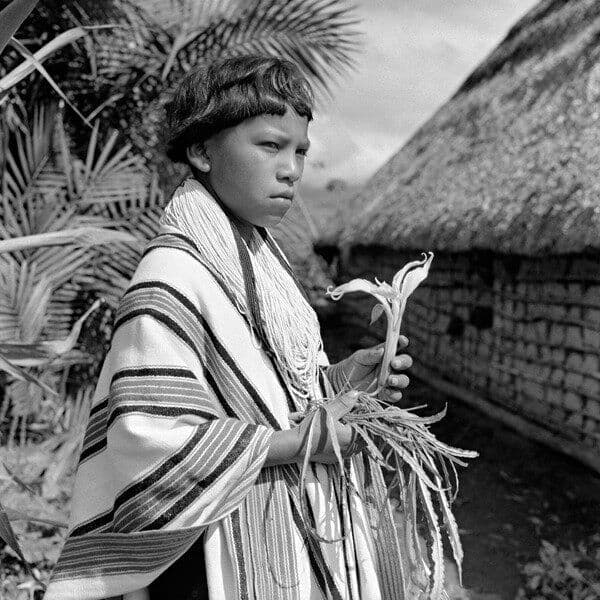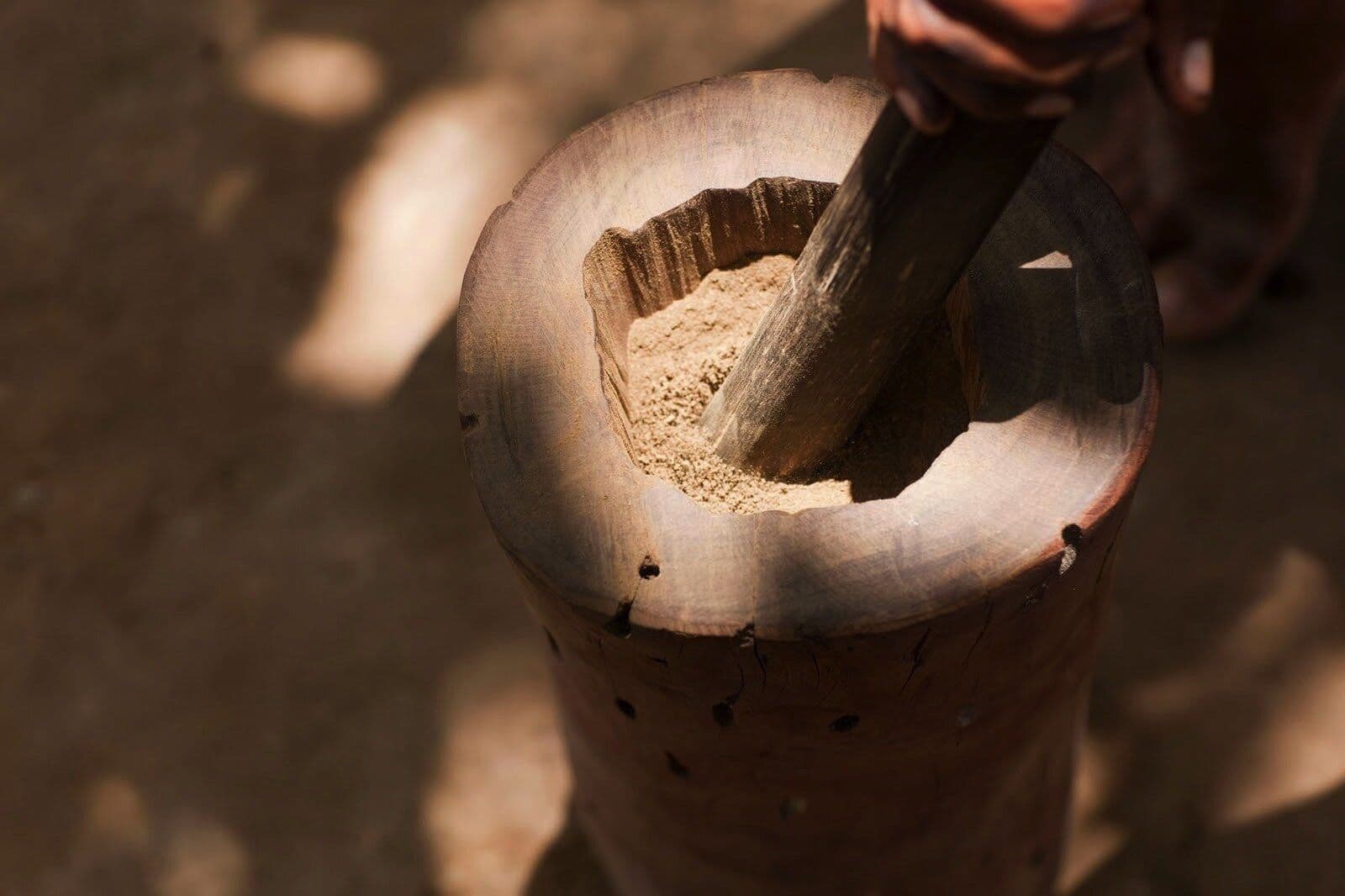Session IV is chaired by Bo Holmstedt (1918-2002), an MD and PhD toxicologist at the Karolinski Institute in Stockholm, Sweden who published and traveled widely and served on the boards of many professional and academic societies. Session IV includes six essays on the preparation and effects of various snuffs used by Amazonian peoples, covering the paraphernalia involved, the common names and (when unknown) likely scientific names of the plants used, and the chemistry and effects of the chemical agents. While the shamanic brew of the Amazon, ayahuasca, has attracted extensive research, increasing use and even the development of therapeutic medicinal applications, investigations into herbal snuffs have not received the same attention.
The first essay is contributed by S. Henry Wassen, affiliated with the University of Gothenburg, Sweden, who published on ethnobotanical-related topics in the 1950s and 1960s. His article in Session IV on the Anthropological Survey of the Use of South American Snuffs details earlier reports from explorers, such as the 1504 letter of Amerigo Vespucci describing the chewing of coca with lime powder, a report by the friar of Christopher Columbus' voyage to the Indies noting the aromatic cohoba (Piptadenia peregrina, P. macrocarpa) snuff used by the Taino, and documents describing tobacco, yopo (Anadenanthera spp) and other snuffs used by the indigenous people of the upper Amazon. He describes snuffing utensils, describing the hollow bones, clay and carved wooden tubes used to apply snuff to the nostrils, the grinding stones, trays, and the decorative figures found on the paraphernalia. He briefly describes the behaviors displayed by men after using various snuffs, and the ceremonies and procedures that surround the use of snuffs in various communities. I have witnessed first-hand many of these ceremonies and beliefs and can say that they persist to this day amongst a subset of Peruvian peoples.
Wassen proposed that the medicines and the practice of snuffs originated in South America and spread to West Indian and Central American peoples based on archeological evidence of the snuffing apparatuses, which are detailed with photos, dates, and maps of the discovery of such artifacts. He gives very little detail of the plants used to make the snuffs, although the numerical legend of his map of South America details the indigenous peoples, offers the common name used by tribes for their particular snuff and what plant it was prepared from. This list mentions Nutmeg (Nux muscoada), Epena (Virola calophylla, calophylloidea), Kokoime (unidentified) , parica/curupa (Mimosa acaciodes), A'ku duwha (the roasted and ground seeds of Piptadenia peregrina), cebil (Piptadenia macrocapa) yopo/yopa/niopa, (Anadenanthera spp and Acacia niopa seeds that are fermented, dried and powdered), ca'ppi (presumably Banisteriposis caapi), and petun (Nicotiana tabacum). Wassen is thorough in his detailing of various animals carved or otherwise depicted on snuffing instruments, such as jaguars, and reports that some tribes held beliefs that shamans and users could be transformed into jaguars, or simply temporarily gifted with the sight, speed and power of a jaguar. Wassen states that the common name of one Methysicodendron species could be translated as "intoxicant of the jaguar". This is common to Amazonian peoples, where hallucinogens are not regarded as drugs or simple intoxicants. Rather the plant is conceived to have a spirit that enters the user and offers its gifts, insights, and powers, its medicine, to the user. Many plants are named for the spirit animals with which they are associated, with names such as "lobo sanango" and "puma Caspi" being used to this day.
The second essay of Session IV is written by Richard Evans Schultes (1915-2001), the Harvard anthropologist often said to be the father of modern Ethnobotany. He is particularly known for his extensive studies in the Amazon exploring the use of entheogenic plants, and his books have become essential texts among anthropologists, ethnobotanists, and psychonauts. His essay on The Botanical Origins of South American Snuffs describes the plants used to prepare snuffs a well as pastes to smear on the tongue, or ointments to apply to the body or the inner nostrils. Schultes describes the use of tobacco species (Nicotiana rustica and tabacum) and details how native varieties were mixed with Piptadenia /Anadenanthera, and how leaves of Theobroma or Cecropia were burned and the ashes used in the snuff mixtures to help maintain the dry powdery quality of the herbs. Schultes informs us that most plants mentioned by Wassen are actually the same plant, because over the course of botanical history, the taxonomy of Acacia, Mimosa, and Piptadenia have been in a state of flux, and most recently have been referred to as Anadenanthera. This plant is a pod-bearing leguminous tree whose thin, flat, shiny brown seeds are processed into snuffs, yet Schultes reported the tree to be rare, and unknown to many tribes who commonly prepared snuffs. During his time in the field from 1941 to 1953, Schultes explored the use of Virola species in the Myristicacea family with the common names yakee or parica. Snuff from species like V. calpylla, C. calophylloidea, and V. elongata is prepared by stripped the bark and scraping off the blood-red resin that accumulates, which is boiled down into a thick paste, dried, pulverized and mixed with cacao ashes. Schultes describes his own experience using the Virola snuff. He also details several other plants considered of "lesser importance", including Olmedioperebea sclerophylla, a Moracea tree, which the Plant List reports is a synonym of Maquira sclerophylla, Justicia pectoralis, an Acanthacea family herbaceous plant and the source of vision-producing alkaloids, the root of an Acanthacea shrub Mendoncia aspera, masho-hara or yauardi-hena, a Piperacea species, and bolex-hena, which is possibly Justicia or a related plant. My own experience with the snuff of these plants is that they all may all be referred to with general words for snuff including rapé, yopo and epena, with rapés commonly containing tobacco in the blend and yopo and epena commonly containing Virola. Schultes mentions the difficulty that I myself have experienced studying ethnobotany in the Amazon, where the diverse common names, fluctuating scientific taxonomy, and difficulty in obtaining certified voucher specimens make plant identification a slow process. Schultes closes his essay by wondering why none of the Datura species (many of which are now reclassified as Brugmansia species) or Banisteriopsis have been utilized in the traditional snuffs. Schultes hypothesizes that usage of snuffs was likely more widespread and employed a greater number of plants than was seen at the time of his field studies. I wonder if the Anadenanthera trees were overharvested, explaining Schultes' difficulty in finding specimens, and whether loss of trees contributed to loss of this tradition compared to the use of ayahuasca.

The third essay by Siri von Reis Althshul, also of Harvard University, focuses on "Vilca" (also known as Wilka or Willca). Professor Altshul suggests that although vilca is most commonly used to refer to a snuff prepared from Piptadenia (Anadenanthera), it likely contains additional ingredients. He details historical field notes where vilca is used in chicha, an "incan champagne" prepared from fermented sprouted corn, and another vilca is reportedly used as a purgative tonic. Althshul searched the herbarium at Harvard University and notes that the common name vilca was associated with Baniesteria leicarpa (Malpighiaceae), Virola sebifera (Mysisticaceae), and Baccharis floribunda (Asteraceae). He also details South American species with possible psychoactive properties because they share common names used to refer to Anadenanthera species in various dialects, such as the common name curupi, a word similar to the curupa mentioned by Wassen. Other common names that are used for Amazonian snuffs overlap with plants that might be suspected to have psychogenic properties, such as caapi, used to refer to Ipomoea morning glory species, as well as used to refer to the ayahuasca plant Banisteriopsis, yaje, used to refer to the legumes Calliandra calothyrsis and Leucaena guatemalensis as well as Banisteriopsis. Furthermore, he reports that the name huillko has also been used to refer to Ipomoea species, and explores the linguistic and etymologic details of the words vilca, wilca, vilcu etc, in the Quechua and Amayra languages, and thereby bringing many important legumes, asters, and medicines into the discussion. These details help make the case that "vilca" does not refer to a single plant, such as the seeds of Anadenanthera alone, but rather vilca snuffs were likely, at one time, a combination of many different plants.
The fourth essay by George J Seitz is a fascinating account of the six expeditions he made with his wife in the 1950s and 1960s to study with the Waika tribes of the upper Rio Negro region near the boundary between Brazil and Venezuela. Seitz filmed and photographed the entire process of making and ingesting epena from Virola resin. He details the Ama asita tree, a Trichillea species that appeared scarce at the time of his visits, and how it was blended with the Virola resin. Ashes prepared from the outer bark of ama asita were mixed 50:50 with the prepared Virola resin, and this mixed with a 3^rd^ ingredient, the small leaves of an herbaceous plant referred to as mashi hiri, purported to be pleasantly aromatic rather than a psychoactive ingredient. Seitz also details his observations of ingesting the epena in the afternoon or evening, typically without pomp or ceremony or obvious purpose, the antics of the user often being ignored by the community members nearby. Only occasionally could ingestion of the snuff, often blown forcefully into the nostril by another community member, be observed to be for ceremonial or healing purposes, such as to assist in curing the ill. He describes the stomping, rhythmic "dance", the blank stare and perfuse perspiration, and the monotonous singing punctuated by intermittent shouts that typify the behavior of the user. Discussions with the Waika epena users revealed that they experienced macropsia -- the sensation of being large -- so large as to be able to converse with beings in the sky, and that users felt big, powerful, and magnificent while doing so. Seitz perceived that the men experienced a sense of exaggerated ego and he used the term "superman" and "braggart" and purported that the stomping dance was enacted to reveal "what a great man I am".
The fifth and sixth essays in this session explore the phytochemistry of the snuffs. Bo Holmstedt and Jan-Erik Lindgren of the Karolinska Institute in Stockholm, Sweden detail the previous work by E.C. Horning, where the seeds of Piptadenia peregrina were found to contain DMT (dimethyltraptamine) and related compounds. DMT is known to promote short-lasting states of altered consciousness, or in the case of ayahuasca where DMT (from Psychotria) is combined with MAO-inhibitors such as beta-carbolines (harmine alkaloids, for example in Banisteriopsis), a long-lasting, highly visual state of altered consciousness. Lindgren and Holmstedt list the tryptamine-based compounds found in snuff samples obtained in 1965 from numerous Amazonian tribes and characterized the type and quantity of DMT and its relatives identified in each snuff sample using chromatography. In their discussion, they say that to date, DMT and carbolines had never been found in tandem in a single plant, causing the team to suppose that the samples containing both compounds were admixtures, and that the samples containing only DMT compounds could possibly be a single plant. While orally ingested DMT is not potently psychoactive, it was hypothesized that when taken as a snuff it could readily affect the brain and elicit a short-lasting hallucinogenic effect when the tryptamines were absorbed through the nasal mucosa and the cribriform plate, entering the brain to affect the central nervous system. They also describe the behavior typical of ingestion described by others and mention macropsia as a frequently observed phenomenon in experimental research with the intravenous use of DMT.
As South America appears to have replaced India, Tibet, and Asian locales as a popular destination for spiritual transformation, the rain-soaked, remote, and mysterious jungles now attract many thousands of spiritual seekers each year. Those seeking to heal from addiction, obsessive-compulsive disorders, treat parkinsonism and numerous physical diseases, overcome depression, or simply further their spiritual journey, flock to ayahuasca retreats, spending time with shamans, and following dietas or learning plant spirit medicine with native healers. Epenas, rapé, and snuffs by various names are still present in the herbal marketplaces of South America and are becoming more, rather than less popular. They may soon receive their turn in the research arena. Biomedicine is presently exploring the traditional entheogenic plants for their ability to alter brain hubs or "wiring", developing novel transdermal and nasal sprays to deliver unique therapeutic molecules, and searching out substances able to penetrate the blood brain barrier to prevent, treat, and slow the progression of the rising epidemic of dementia worldwide. Advancing the research on herbal snuffs could mature into natural products with many therapeutic applications.

